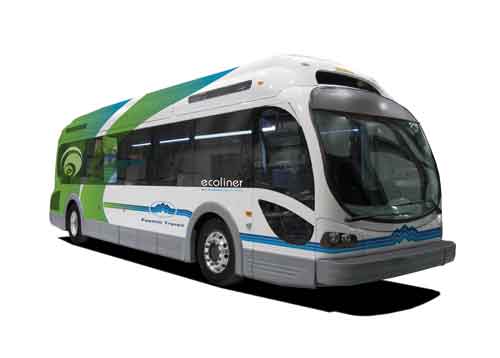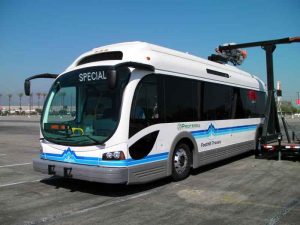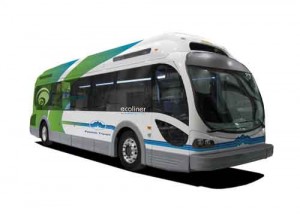
Proterra leads the way
By Glenn Swain

As all-electric buses continue to make greater inroads into the motorcoach and transit industries, the terminology is slowly changing from miles-per-gallon to miles-per-kilowatt. Although the Chinese have been using some form of electric bus for years, an increasing number of agencies in the U.S. are accepting and utilizing all-electric transit vehicles. Fleets now sport sleek, all-electric vehicles with the capacity to save thousands of dollars over a vehicle’s lifetime. Also, technology has improved to the point where recharging can be done in minutes.
Leading the way is Proterra, Golden, CO, providing efficient and environmentally responsible battery-electric buses built from the ground up. Proterra President and CEO Jeff Granato says agencies in Seattle, WA, Tallahassee, FL, San Antonio, TX and transit authorities in Canada are eager to adopt the new electric technology. In August, a Proterra team travelled to South America to meet with potential customers.
“We’re finding that there are a number of transit agencies across the country very eager to begin adopting the technology into their agencies and fleets,” Granato says. “As the interest grows the government is making more capital available. Over 25 major transit agencies submitted applications to the government to purchase vehicles.”
“The biggest selling point for cities is that they can have a battery-powered bus that can operate on the exact same route as a diesel or a CNG bus,” says Joshua Goldman, Proterra’s director of business development. “And it’s all without overhead wires and the need to charge for hours in a shop.”
The Proterra team believes all-electric vehicles are the future of transit. Granato cites a Federal Transit Administration white paper that reveals the government’s lean toward green energy for public transportation. Proterra will break ground later this fall on its Columbia, SC plant to meet the demand. It will open September 2011.
Foothill Transit goes green
Thanks to the government’s economic stimulus program, West Covina, CA-based Foothill Transit was awarded six million dollars to begin operating its new electric transit bus line.
Three new buses began rolling in September. If all goes well, Foothill has an option to purchase nine more in the near future. The all-electric buses will be a big change from the company’s diesel-heavy fleet.
Company officials are calling the Ecoliner the first heavy-duty, all electric, fast charging public transportation vehicle. Expectations are high. Foothill has assembled a team of partners who produce technology to make an all-electric bus more than feasible.
“We expect that they will exceed the FTA’s expected life time,” says George Karbowski, Foothill Transit’s director of operations. “We expect that because of the composite structure of these vehicles, they could provide solid transportation service for 18 years or more.”
Karbowski decided early on to put the new buses on Foothill’s Line 291, and for good reason.
When he started to put the buses in service Karbowski wanted a route that would provide a really tough test.
“We chose a 19-mile, roundtrip route that travels north and south in our area between the cities of La Verne and Pomona,” he says. “It is a very transit-dependent line and not a commuter line. The route carries about five percent of our annual ridership with only three percent of our buses.”
Karbowski says because of doctors’ offices and the hospital on the line, it has a high number of wheelchair boardings, another test for an electric bus.
“This is literally the toughest service I could find,” he says. “No one could say we were just showcasing the vehicle. We want to show people that this is a real opportunity to use a full electric bus on a real heavy-duty transit line.”
Foothill Transit is working in conjunction with Southern Cal Edison to assure the buses stay rolling and remain in service. From the beginning Foothill Transit wanted to know if the electricity being used was renewable. Southern Cal Ed touts itself as the nation’s largest purchaser of renewable energy, buying and delivering approximately 12.6 billion kilowatt hours (kWh) from wind, solar, biomass, geothermal and small hydro suppliers—almost 16 percent of the power it delivers.
“Southern Cal says the supply of electricity we use comes from renewable resources in a mix of fossil-fuel fired power plants,” Karbowski says. “We determined through the department of energy that there is a program that allows us to buy something called an REC, or renewable energy credit. Brokers buy energy for wind sources, for example, and put that energy into the grid. The energy taken out on the other side, while it might have come from a fossil-fueled energy plant, will always be replaced by renewable energy.” He says the cost for credits is a minor cost, but it does come with the technical guarantee that the electricity use for the Ecoliner will be replaceable on the grid by renewable energy.
Over the next six months Foothill Transit will collect data points and other vitals on the vehicle to determine how it measures up to every day abuse.
Foothill Transit riders will know immediately they are being transported on an electric bus. Doran Barnes, Foothill Transit’s executive director, says a graphic overlay on the back of the bus will give it an unmistakable, distinctive look. That ties in with the concept that this is a green technology.
Barnes says yearly ridership on the route amounts to more than 714,000 people, or nearly 60,000 boardings a month.
“We’ll be collecting all sorts of data points in the next six months,” Barnes says. “If the vehicle meets our specifications, then we could exercise the option for the additional nine.”
Supporting technologies
A wide variety of companies provide technology products to support all-electric transit. Reno, NV-based Altairnano is a leader in energy storage systems. The company’s lithium-ion systems and batteries are aiding in the demand for sustainable and economically-friendly power and energy for transit vehicles.
Another industry leader is UQM Technologies, Longmont, CO, which makes electric power systems.
“Our motors provide the opportunity for better packaging and they occupy less space and weigh less,” says company CEO Bill Rankin. “We have much higher efficiency than other technologies along with sophisticated controls so the user can direct the motor as needed.”
ISE in San Diego, CA develops and manufacturers heavy-duty hybrid electric drive systems focusing on energy storage, control software and power electronics.

“Every thing we provide is electric drive,” says ISE Chief Science Officer Dr. Paul Scott. “They’re hybrid electric in a sense that they have electrical storage.”
Scott sees the multiple applications where all-electric makes sense – and some where it doesn’t make sense as well.
“The transit experience is one of corner-to-corner, start and stops,” Scott says. “They’re the ones that can store the energy with an ultra capacitor or battery and use it to accelerate again, trading the energy forms back between kinetic and stored electric.”
Where it doesn’t make sense, Scott says, is on longer hauls where there is far less acceleration and deceleration. In those cases a bus is basically carrying the batteries instead of using them.
Scott cites ISE’s fuel-cell buses, which he calls very efficient. A number of buses the company just shipped to London have been tested to equate to nearly 15 miles per gallon for a regular vehicle and have a 400-mile range.
Scott says charging systems for electric transit is confined to the amount of power that can be drawn from the grid.
“There are not a lot of charging stations that could be set up for a mega-watt charging,” Scott says. “As a result they will charge more slowly, so now more stations are needed. It then becomes an infrastructure problem.”
With the constant advancement of technology and the government’s push for vehicles that are better for the environment, all-electric public transportation is here to stay. Passengers are slowly beginning to notice a difference between electric- and diesel-powered vehicles. The new technology is proving itself to be the future for not only U.S. carriers, but for agencies around the world. The advantages of electric transit are now outweighing those fuel-burning options of the past.
All-electric is in. BR

While I applaud the move towards all-electric buses, the major issue with this kind of motive power – in terms of economics – is that the battery systems require replacement after x number of recharges. In recent studies in which I have been a part, this equates to battery pack replacement every two years, at costs ranging from $2,000 to $4,000. There has been some interesting work done with capacitors in recent months, but the main stumbling block is battery replacement and what do you do with defunct batteries? Moreover, deploying electric drives in standard buses is a fool’s errand. The extra weight drags down the efficiency of the whole system and defeats the purpose. The Econliner – a combination of composites and aluminum components – is on the right track. Reduce the weight of transit vehicles – even those with standard or hybrid electric drives – and you will reduce fuel consumption, GHG contribution, infrastructure degradation, and operating costs.